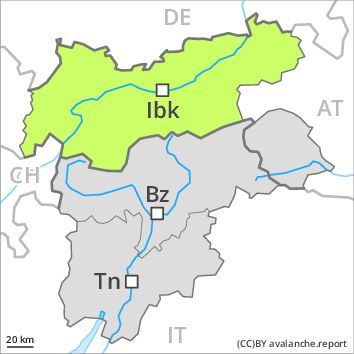Regions
Weißkugel Range, Western Verwall Mountains, Gurgler Range, Eastern Verwall Mountains, Central Stubai Alps, Silvretta, Northern Zillertal Alps, Allgäu Alps, Samnaun Mountains, Eastern Lechtal Alps - Ammergau Alps, Northern Oetz and Stubai Alps, Mieming Mountains, Western Tuxer Alps, Karwendel Mountains, Eastern Tuxer Alps, Brandenberg Alps, Western Kitzbühel Alps, Wilder Kaiser Mountains - Waidring Alps, Eastern Kitzbühel Alps, Western Lechtal Alps, Glockturm Range, Central Lechtal Alps, Grieskogel Mountains

Danger level
Danger Level 1 - Low
Avalanche Problem
Wind-drifted snow above 2200m, N-NE-NW

A favourable avalanche situation will be encountered over a wide area. Fresh wind slabs require caution.
The fresh wind slabs are to be evaluated with care and prudence above the tree line. The avalanche prone locations are to be found in particular in northwest to north to northeast facing aspects. Mostly avalanches are only small but can be released in isolated cases by a single winter sport participant. The wind slabs are clearly recognisable to the trained eye.
A certain danger of gliding avalanches exists. Slight increase in danger as a consequence of warming.
Dry avalanches can in very isolated cases be released in the old snowpack, mostly by large additional loads, in particular on very steep shady slopes. Transitions from a shallow to a deep snowpack are unfavourable.
Snowpack
dp 6: cold, loose snow and wind
The southerly foehn wind will transport only a little snow. In some places wind slabs are lying on old snow containing large grains, in particular on shady slopes.
Faceted weak layers exist deeper in the old snowpack in particular in areas where the snow cover is rather shallow, especially on very steep shady slopes.
Tendency
Slight increase in avalanche danger in shady places that are protected from the wind.
Regions
Sexten Dolomites, Latemar, Val Müstair Alps, Langtaufers, Schnals Ridge, Southern Stubai Alps, Southern Zillertal Alps and High Tauern, Saldurn-Mastaun Ridge, Texel Mountains, Southern Adamello, Sarntal Alps, Adamello - Presanella, Western Pfunderer Mountains, Northern Brenta - Peller, Bondone and Stivo, Folgaria - Laverone, Southern Brenta, Southern Lagorai, Northern Lagorai, Maddalene, Pine' - Mocheni Valley, Eastern Pfunderer Mountains, Durreck Range, Western Rieserferner Mountains, Western Deferegger Alps, Ortler Range, Ulten Valley, Venediger Range, Eastern Nonsberger Alps, Eastern Rieserferner Mountains, Northern Dolomites of Fiemme, Glockner Range, Gröden Dolomites, Primiero - Pale di S. Martino, Eastern Deferegger Alps, Prags Dolomites, Prealps, Schober Mountains, Cembra Valley, Lienzer Dolomites, Vallarsa, Western Nonsberg Alps, Fassa Valley, Sole, Pejo and Rabbi, Ledro Valley, Paganella, Marzola - Valsugana

Danger level
Danger Level 1 - Low
Avalanche Problem
Wind-drifted snow above 2200m, N-NE-NW

A mostly favourable avalanche situation will be encountered over a wide area. Fresh wind slabs require caution.
The fresh wind slabs are to be evaluated with care and prudence at high altitudes and in high Alpine regions. The avalanche prone locations are to be found in particular on northwest to north to northeast facing wind-loaded slopes. Avalanches are rather small but can be released in isolated cases by a single winter sport participant. The wind slabs are clearly recognisable to the trained eye.
A certain danger of gliding avalanches exists. Slight increase in danger as a consequence of warming.
Dry avalanches can in very isolated cases be released in the old snowpack, mostly by large additional loads, in particular on very steep shady slopes as well as adjacent to ridgelines. Medium-sized avalanches are possible. Transitions from a shallow to a deep snowpack are unfavourable.
Snowpack
dp 6: cold, loose snow and wind
The southwesterly wind will transport the loosely bonded old snow. In some places wind slabs are lying on old snow containing large grains, in particular on shady slopes.
Faceted weak layers exist deeper in the old snowpack in particular in areas where the snow cover is rather shallow, especially on very steep shady slopes.
Tendency
The backcountry touring conditions are generally favourable.


